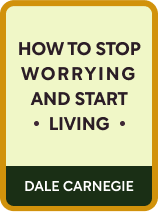

This article is an excerpt from the Shortform book guide to "How to Stop Worrying and Start Living" by Dale Carnegie. Shortform has the world's best summaries and analyses of books you should be reading.
Like this article? Sign up for a free trial here .
Do you often find yourself stuck on small everyday worries and annoyances that just wouldn’t go away? How can you break free of this everyday anxiety?
Everyday anxiety has the power to take over your thoughts and emotionally exhaust you. Reframe the way you think about your day-to-day worries to take away their negative power.
Here are six ways to get a handle on generalized anxiety.
Generalized Worrying
Like most people, you probably often find yourself caught up in a sense of generalized worry about your day-to-day life. Everyday anxiety can be difficult to work through because it’s usually not based on specific issues that you can gather facts and information about. Rather, this generalized everyday worry is simply a habit to be broken. There are six ways you can break your worry habit.
Method #1: Keep Busy
Often you’ll find that worry and anxiety creep up during your idle moments. Keeping your body and mind as busy as possible is an effective way to keep worry at bay, and perhaps forget about it completely. This is because it’s impossible to actively think about two things at once—for example, try simultaneously thinking about what you had for breakfast this morning and a task you need to complete tonight. You’ll find that you can think of both of these things in turn but not at the same time.
In the same way, your emotions can overrule one another—you can’t feel joy and despair at the same time, for example. When you keep your mind occupied with productive and positive thoughts, it can’t also be occupied by worry and anxiety.
- For example, your friends might take you out for dinner and drinks after a breakup—providing you with a fun, social environment helps distract you from feelings of sadness or loneliness.
Idle worry usually isn’t too much of a problem while you’re focused on your work during the workday. However, you’re at a much higher risk for anxious thoughts while you relax in your after-work hours. Combat this risk by occupying your mind with positive after-work activities. This might look like:
- Joining new activities, like a sports team, a class, and so on.
- Developing a hobby that requires some concentration, such as learning a new instrument or painting.
Method #2: Reframe the Small Stuff
A strange paradox of human nature is that we usually approach life’s true hardships and setbacks bravely and logically, but easily become emotional and reactive when it comes to small, unimportant matters. This is because we ruminate on these small matters until they become overwhelmingly important and take up our focus.
Many of life’s large stresses are simply a buildup of small problems. For example, small irritations with your spouse can build into irreparable resentment and divorce. Or, someone spilling their drink on you at the bar can escalate into a fight and an assault charge.
You can avoid your tendency to fret about small matters and let them become large, stressful matters by reframing your thoughts in two ways.
- Ask yourself: Am I going to let this setback ruin my experience? Imagine someone makes fun of your shirt at a party. You’re upset and feel like crying or leaving the party. You think, “Am I going to let her comment ruin a fun night with my friends?” You decide to just avoid the person for the rest of the night and enjoy talking to your friends.
- Adjust your view—think of how you can make the irritation more pleasant. For example, Carnegie tells the story of a man who hated his radiators’ incessant clicking noises. One day, he was on a camping trip and realized that the crackling campfire sounded a lot like his radiator. When he got home, he decided to enjoy how his radiators sounded like a campfire—once he did this, he stopped being irritated by the noise and forgot about it completely within weeks.
Method #3: Think About Probability
Many people tend to worry about everything—accidentally setting their house on fire, natural disasters, plane crashes, and so on. Often, though, once you step back and examine these anxieties, you’ll find that most things you worry about haven’t come to pass, nor are they likely to. Consider how realistically probable the things you’re worrying about are. When you catch yourself falling into your generalized worry habit, ask yourself:
- What am I worrying about?
- Is it likely to happen?
So many of our worries come from our imaginations, not from our reality—these questions interrupt your irrational spiral of imagination and pull your thoughts down to rational, factual ground.
Method #4: Accept What’s Out of Your Control
Throughout your life, you’ll encounter situations that are completely out of your control and can’t be changed. Pushing against the inevitable won’t do anything to change the situation—but it will certainly change you by making you angry, resentful, and physically ill with worry.
These situations become less stressful and frustrating when you practice acceptance—instead of trying to change your circumstances, cooperate with your circumstances.
- For example, the night before Thanksgiving, your power goes out and you receive word that you won’t have it back for a few days. Instead of becoming upset that you won’t be able to host dinner as planned and frantically trying to find a way to make it work, you accept that Thanksgiving won’t be happening at your house this year. Your sister a few towns over says that she still has power, so you bring over all the food you prepared and host the festivities there instead.
This isn’t to say that you should immediately give up when you encounter any type of adversity. If you encounter a situation that you can control or change, try your best to do so. But, if no action on your end can change or prevent the issue, let it go and find a way to accept it. When you stop wasting your time and energy on things you can’t control, you can put that energy into enriching and enjoying the parts of your life you can control.
Method #5: Put a Limit on Anxiety
Unfortunately, it’s easy to get caught up in worrying about issues that, in the end, aren’t very important. When you’re worrying about something small, think about how much time and energy it’s really worth. Then, set a limit on your anxiety—that is, allow the issue only the time and energy it deserves.
Determine appropriate limits by asking yourself three questions:
- How much do I really care about this issue?
- How much of my time and effort has already been wasted on this issue?
- How much of my time and effort am I willing to further spend on this issue?
For example, you have a friend who always shows up late to plans. You spend hours of your life worrying about losing your reservations and feeling frustrated that you need to wait around for them. You decide to set a limit on how much time their tardiness can take in your life. You tell them, “Let’s meet for lunch. I’m going to be at the restaurant at 12:30, and I’ll wait 10 minutes for you. If you’re not there, I’m going to go ahead and eat or find lunch elsewhere.”
Method #6: What’s Done Is Done
Many chronic worriers tend to ruminate on the past—things you’ve said or not said, mistakes you’ve made, or decisions that might have led you in a much different direction in life.
This is a useless exercise. No matter what you do, you can’t change actions and decisions that have already happened. You can, however, do your best to mitigate or manage the outcomes of those actions and decisions. This may look like committing to your chosen path, changing course, or finding small ways to better your circumstances.
- For example, after college, you moved to a new city and started a new job—neither of which you particularly like. Instead of thinking, “This was a terrible decision, and now I’ve wasted the past five years of my life,” you might try, “It’s time to make a few major changes so I can be happier. Fortunately, I’ve learned a lot about what I don’t want, so I won’t make those mistakes again.”

———End of Preview———
Like what you just read? Read the rest of the world's best book summary and analysis of Dale Carnegie's "How to Stop Worrying and Start Living" at Shortform .
Here's what you'll find in our full How to Stop Worrying and Start Living summary :
- What worry is and how it manifests both physically and mentally
- How to deal with worry about work, finances, and criticism
- How to cultivate a less worried mindset






